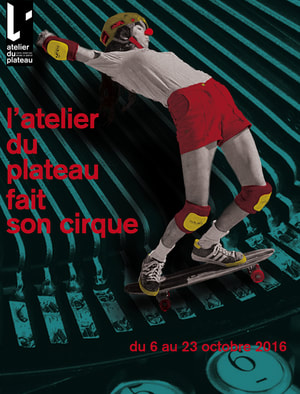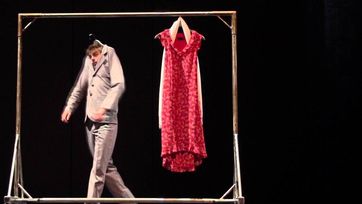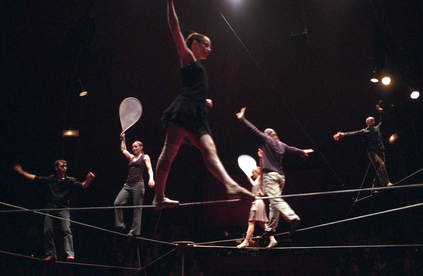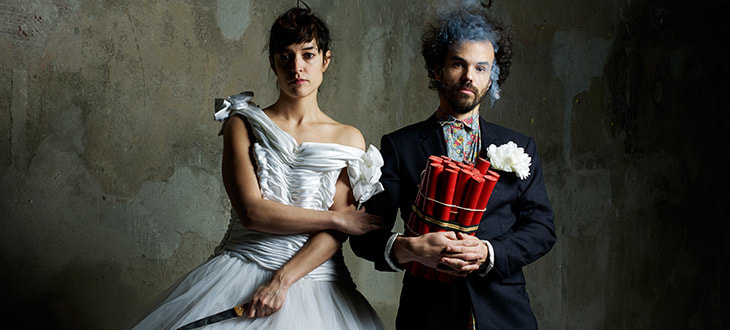 L'Atelier du Plateau reminded me of the original Cirque Lab in Bellingham, Washington. It has a small floor plan, but high ceilings and an industrial look. The layout was more laid back than many of the professional venues I have been to in Paris, with as many folding chairs as possible crammed into the tight space, surrounding an open piece of the floor that became the stage. The performance was a variety show with themes that seemed to tie the acts together (though again my comprehension of the spoken parts may have been a bit weak). Several acts started with performers coming from the audience, acting as if they were mere spectators interacting with the performance. There were many moments of physical or social awkwardness that would be transformed into virtuosity by the performers interaction with their chosen apparatus. This was the 16th edition of the "fait son cirque" series, a collaboration between circus performers and musicians. Each night of the run different performers create an entirely new show, linking their acts with rotating live musical accompaniment.
0 Comments
If the last few shows I attended were independent films at a local theatre, Cirkopolis was like seeing a Hollywood blockbuster at a Cineplex. Loosely based on Fritz Lang's Metropolis, a cast of multidisciplinary circus artists use acrobatics to rebel against the monotony of corporate life. The show is, at times, overstimulating with its pop music soundtrack and backdrop of cityscape projections. Overall the performance reminded me of Jaques Tati's film Playtime. There was a frenetic atmosphere with characters who spoke a jumbled and rapid mix of different languages and gibberish. The group numbers and comic pieces were engaging and expressed a contagious feeling of playfulness, but the serious portions seemed to lack the emotional relevancy they were searching for.  My favorite portion was when one of the clown characters tried to impress a woman who was made from empty clothing and a clothes hanger. Perhaps I'm slightly biased because he managed to find a clothing rack that was far more stable than the one I used in my own show, so he was able to use it as an apparatus to much greater effect. Personal jealousy aside, his character made me laugh out loud and provided an excellent transition into the following trapeze act. I always admire the ideas coming from the big circus companies in Montréal and their skills are at an unarguably high level, but often the final product seems slightly unoriginal and contrived. To refer back to the metaphor I opened with, these shows are fun and inspiring on a technical level, but rarely leave me with a deeper sense of meaning. The setting for this show was a web of tight wires at various heights. Platforms just big enough for a foot connected each wire. One man opened the show with a monologue, telling the story of his twenty years as a wire walker, a career that ended after a fall at the beach left much of his body paralyzed. Though not directly stated, the performance seemed to be memories from his life before his fall--his growth as an artist, his successes and failures on the wire.
Seven performers blended dynamic and often anxiety inducing tricks with character interactions that ranged from romantic to playful to competitive. A live band heightened the action and anxiety with well timed musical accompaniment. Discordant sounds built tension as performers prepared themselves for spectacular tricks such as backhandsprings or backtucks on the springy wire. Though the show was full of technically skilled physical performance, close attention was paid to the narrative arc. The show had several phases, starting with a curious and playful beginning and transitioning to the struggle of acquiring new skills and relationships. Later it moved to choreography that seemed to be an allusion to Pina Bausch's, with a solo performer awkwardly moving along the lines, slamming her body into other wires, like the repeated movements in Café Müller. The performance ended with one woman on the wire and the paralyzed man standing below. In synchrony they walked along their individual lines, the woman on the physical wire, and the man on its shadow below. This is the first performance I've attended since returning to Paris, and it helped me remember why I keep coming back to this city for artistic inspiration. I was told this was a show I had to see because though it was categorized at circus/music/theatre, it truly created a genre of its own. Blending live music, circus stunts, humor, and poignancy, two performers, Tsirihaka Harrivel and Vimala Pons, share small reviews of individual moments. Though there was a reasonable amount of speaking in the performance (and my French still needs some work), I was thoroughly entertained and able to follow the general themes.
Arranged on a series of tables is a mess of objects. Through the performers' interactions with these objects the importance of their seemingly innocuous nature is brought to light. A cross becomes a sword, a door a view screen, and a shelter a coffin. Harrivel and Pons create live music on an elaborate set of instruments, utilizing delayed sounds and repetitions. The music runs parallel to many of the repeated circus acts, though just like the music each of these repetitions have slight alterations. The performers' chosen circus acts are symbolic of aspects of each character's personality. Pons is constantly weighed down by alternating objects, from a life-size mannequin to a washing machine, while Harrivel is repeatedly lifted by each object he holds, attached to an electronic crane, to be dropped again and again down an eight meter chute. Grande juxtaposes banality and brutality, tenderness and violence. It can best be summed up by a line in its synopsis: "it resembles a juke box distributing poems." |
Archives
August 2019
Categories |


 RSS Feed
RSS Feed